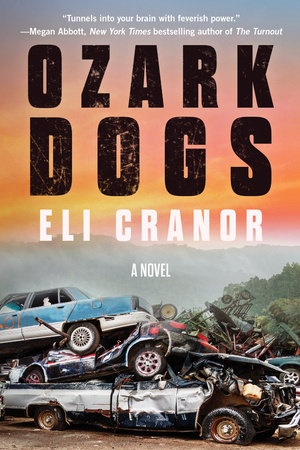A Review of Eli Cranor’s Ozark Dogs
By Wiley Reiver
Eli Cranor’s 2022 debut novel Don’t Know Tough rightly garnered impressive critical notice, being among USA Today’s “Best Books of the Year” and the New York Times’ “Best Crime Novels.” In addition, the Mystery Writers of America recently nominated it as a Best First Novel by an American Author. His forthcoming follow up Ozark Dogs demonstrates beyond question that he’s easily evaded the dreaded “second novel slump.” While I question a couple key aspects of the book, it nevertheless, like his first, confirms Ace Atkins’ judgment that Cranor “is a new voice of the South to watch.”
Ozark Dogs is inspired by two murders in 2016 in Cranor’s hometown of Russellville, Arkansa. It’s set in the decaying small town of Taggard and centers on the slithered entwinings of two families. The Fitzjurls are headed by Jeremiah, a Vietnam vet nicknamed The Judge because of his stellar execution skills as a sniper. His wife died by suicide after he returned from the war, his son Tommy is imprisoned for murder, and he is the gnarled, gruff guardian of Tommy’s teenage daughter Jo. Jeremiah is a hobbled, angry man haunted by ghastly memories of his war-making, gnawed by guilt and sorrow over the fate of his boy, and queasily frightened by the prospect of Jo moving into a fully blossomed womanhood as well as the prospect of her leaving Taggard in pursuit of a college education. The first thing we witness him doing is destroying the letter announcing Jo’s acceptance into the University of Arkansas. Later he’ll give in to his drinking demons, climb atop a stack of crushed junkyard cars he calls Babel, and drunkenly blow away several of the dogs he barely feeds in order to increase their savageness against trespassers. Jeremiah Fitzjurl, that is, has a name Flannery O’Connor would have been proud to come up with and tendencies that would make him at home in Harry Crews’ nastiest, darkest novels.
And then there are the Ledfords. Sweet Jesus, the Ledfords. Headed by Bunn, a racist meth dealer whose face is made more grotesque from only half of it having been horribly burned. He’s married to Belladonna, who, despite the lethality suggested in her name, is one of the very few characters in the novel with a recognizably human soul. Their second son Evail affects modes of speech and movement that place him all out of the context of his upbringing and environment. These elements of his character, along with his clearly sociopathic intelligence make him as unnerving as a rattler coiling up to strike. Despite the white supremacy that grounds his father’s life and values, Evail has begun working with a Mexican cartel to increase the Ledfords’ grip on drug dealing in the area. The deal he struck trades vast amounts of meth for white women forced into sex trafficking. Evail’s older brother Rudnick is dead when the novel opens, and his killing, it becomes clear, is a vital key to the violence and bloodshed that fill this novel..
Actually, merely calling this book a novel obscures something very important about it. The deeper I read into Ozark Dogs, the more I came to think of it as a kind of grotesque fairy tale. Of course, anyone who really pays attention to fairy tales knows how harrowing and black they can be, and this story is filled with mythopoeic elements that are found in fairy tales around the world. The first sexual intimacy between Jo and her star quarterback boyfriend Colt Dillard sets in train a series of events that lead to degradation, defilement, and death. As alluring as Jo is to Colt, her sexuality, most powerfully expressed in a pair of lacy red panties she discards at one point in a dark forest, is frightening and weird to Jeremiah, even as he can’t stop fixating on her erotic transformation.
Further, when Jo escapes a kidnapping by the Ledfords (she’s an intended part of the trade with the Mexicans), her fleeing involves a literal stripping away of most of her clothes and she must move into and then emerge from dangerous waters to evade recapture. A baptism, a kind of rebirth. Also, there are two foundlings in the novel, with conjoined fates, and hidden identities recovered only at great cost. Colt is an adolescent who must brave lethal danger to be the man his love for Jo inspires him to be. An Ozark Luke Skywalker, if you will. He needs the guidance and help of Jeremiah, who is what passes in this novel for a wise man, to achieve this transformation. Which Jeremiah, in his own curdled way, provides . . . until he doesn’t. And Jeremiah at times must resort to disguise, in the form of his Vietnam era ghillie suit, in his quest to rescue Jo. So it’s a truly impressive feat, intended or not, for Cranor to weave into contemporary Southern noir some of the most resonant elements of timeless narratives. In this way Ozark Dogs, while obviously different in many respects, still strongly reminds me of Ross MacDonald’s Lew Archer novels, which often incorporate themes and images drawn from classic mythology.
All in all, then, this is a rich, satisfying novel. But I want to briefly note two things that, for me, don’t fully work. The first and less problematic is the switching between chapters from one character or set of characters to another. The story usually continued on smoothly, but more than once I found a given chapter underdeveloped or fragmentary. Quickly ending such a chapter and then diving into a very different part of the plot drew me out of that “vivid and continuous dream” John Gardner says good fiction aims to create.
More troubling for me is how Cranor leads us to a realization of the past choices that have caged these families in cycles of deceit and revenge. I realized something was off when I’d read well over a third of the story and still didn’t have a reliable sense of its central conflict. That might be partly due to the number and relative complexity of the plot’s main threads. Cranor makes a lot of moves with numerous characters in only 290 pages. But it has more to do with how he handles suspense. There are plenty of hints about critical past events that Cranor leaves along the way, but those clues don’t adequately accrete or intensify tension. What we need to know eventually comes to light, yet it feels more like an announcement than the climatic result of well-managed profluence. And as I look back over the story, I don’t quite see what we find in the best of thrillers–that sense in retrospect of how all the clues really were there, if we’d only known better how to connect them.
Nevertheless, Ozark Dogs is a damn good book and well earns a place of pride alongside Don’t Know Tough. The corrosive force of lies, the gutting of a town through economic decay and drugs, the myriad ways men stubbornly inflict violence on themselves and others, the fragility of our best impulses in our hearts, our families, and our communities are all depicted convincingly and powerfully. Cranor is a writer with the courage and skill to portray what ravages our humanity, and what of it, somehow, sometimes, survives. So if you’re lucky, the line of Eli Cranor novels on your bookshelf will grow for years to come.


Wiley Reiver
Wiley Reiver is from the South Carolina Lowcountry but currently lives in Vermont’s Northeast Kingdom. He works in university administration. He’s also been a picture framer, college English teacher, ESL instructor in Iraq, racetrack bathroom cleaner, and very bad maker of donuts. He holds an MFA from the University of Southern Maine. His fiction and nonfiction work has appeared under other names in the New York Times, Fried Chicken and Coffee, the Civil War Monitor, and The Dead Mule School of Southern Literature. He’s at work on a New Orleans crime novel. Twitter: @SFWriter3.
